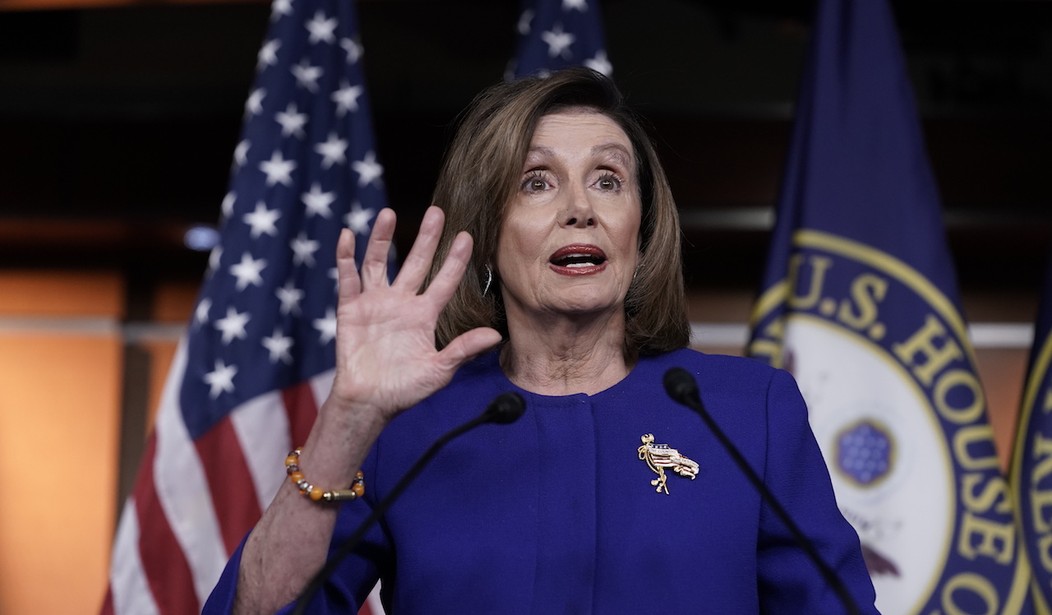It was just a little over 10 years ago, at the height of the 2008-2009 financial crisis, that House Speaker Nancy Pelosi said one of the dumbest things in modern times. The best way to stimulate the economy, she declared, was with "unemployment insurance and food stamps." Right. Paying people not to work will get more people to work.
Now here we go again. In the throes of the COVID-19 financial crisis, Pelosi is still spreading her economic pixie dust. Maybe it is just an inviolable rule of politics that politicians never seem to learn from their past mistakes.
The economy is now partially paralyzed from fear of the virus, so Republicans and Democrats want to do something to juice the economy. President Donald Trump's big idea is to cut taxes.
This may not do much to suspend the fear and gridlock that has gripped the economy, but it can incentivize more work (by allowing every worker to keep more of their own money) and can accelerate spending at a time when demand has fallen off the cliff.
Economists can debate back and forth about how well a tax cut will work to avert an economic calamity, but it can't hurt. What is for sure is that this plan is far more likely to succeed than what Pelosi and her Democratic colleagues want. They favor paid leave for workers who don't come to work (which incentivizes nonwork), unemployment insurance, Medicaid expansion, bailouts for hard-hit industries and so on.
Spend, spend, spend.
History teaches us that these kinds of so-called stimulus plans always fail. The mother of all government spending plans was the failed $830 billion fiscal stimulus during Barack Obama's first months in office. Obama's first chief of staff, Rahm Emanuel, explained the rationale in early 2009 by stating: "A crisis is a terrible thing to waste."
Time magazine put Obama on its cover with a cigar and a top hat, looking like a dapper Franklin Roosevelt circa 1932. It was fitting because Obama had in mind a supersized New Deal. The promises were alluring. Obama told us that the money would be spent quickly on vital "shovel-ready projects." Soon after it passed, Vice President Joe Biden famously predicted that 2009 would bring "the summer of recovery" -- which never happened because the unemployment rate continued to rise.
Recommended
The giveaway was always less about resuscitating the economy and more about spreading hundreds of billions of dollars to left-wing interest groups. There would be money for the National Endowment for the Arts (how does that stimulate the economy?), Head Start, unemployment insurance and food stamps for illegal immigrants, renewable energy subsidies, high-speed rail, Cash for Clunkers and Medicaid expansion. The whiz kid economists in the Obama administration predicted a 2009 growth rate north of 4.5%. It barely got to 2%.
By the Obama administration's numbers, every year from 2009 to 2011, unemployment came in much higher than Obama's team predicted it would have if we had done nothing. Many of the shovel-ready projects, such as the $535 million that went to the now-bankrupt solar company Solyndra, turned out to be lemons or scams.
The stimulus didn't work because it ignored the very nature of government activity, which is the feds can only give money to Peter by taking money from Paul. With a tax cut, instead of making money from Peter, it lets Peter keep it.
Harvard economist Robert Barro explained during the Great Recession why the spending spigot didn't grow flowers: "Every time heightened fiscal deficits fail, the policy advice is to choose still larger deficits," he concluded. "The results from following this policy advice are persistently lower growth and an exploding ratio of public debt to GDP."
Obama and his aides are now trying to rewrite history to persuade the public that the Recovery Act of 2009 was a grand success. Obama recently tweeted that his policies set the table for the Trump boom of the last three years. In reality, in the Obama years, the bar on growth and wages was so low that it was easy for Trump to hurdle over it.
The most famous "stimulus" failure was FDR's New Deal of the 1930s. It more than doubled government spending as a share of GDP but never got the unemployment rate down below 10% in the entire decade of the 1930s, as Amity Shlaes documented in her book about the Great Depression, "The Forgotten Man."
Trump understandably wants to act, and quickly. But he would be wise to avoid cutting a deal with Pelosi that forces him to waste taxpayer money or puts additional mandates on employers already getting crunched by the effects of the coronavirus. In this case, the palliatives could delay or impede a big economic snapback. In 2009, at the end of the day, all we got from the Obama stimulus was nearly $1 trillion of added debt and millions more people enrolled in welfare programs. Washington, aka "the swamp," got rich from the largesse, but not so much the rest of the country.
Picking winners and losers among industries such as airlines and energy companies (an idea that both parties appear to like) is inequitable because just about every sector is getting hammered. Who chooses who gets a new lease on life and who doesn't? The best solution to averting bankruptcies in an uncontrollable event like this is for the Federal Reserve to open its discount window for low-interest loans to distressed companies with collateral but little revenue stream thanks to the virus.
There are so many uncertainties about where the coronavirus is taking our economy and for how long, but the one thing we do know for sure is that the government can't spend and regulate our economy or our country back to health.
Stephen Moore is a senior fellow at the Heritage Foundation and an economic consultant with FreedomWorks. He is the co-author of "Trumponomics: Inside the America First Plan to Revive the American Economy." To find out more about Stephen Moore and read features by other Creators Syndicate writers and cartoonists, visit the Creators Syndicate website at www.creators.com.
























Join the conversation as a VIP Member